INTS2006/2007: Women Studies Article Summary and Critical Response
VerifiedAdded on 2022/09/28
|6
|1813
|28
Report
AI Summary
This report provides a comprehensive summary and critical analysis of Jane Doe's article, "The Ultimate Rape Victim." The assignment, completed for an INTS2006/2007 Gender and Women's Studies course, explores societal conditions contributing to rape culture, victim blaming, and the experiences of rape victims. The author's personal narrative and analysis of legal, governmental, and social systems are examined. The report critically evaluates the article's relevance, highlighting the persistence of victim-blaming, and proposes solutions such as training programs to address these issues. The analysis also considers the article's strengths and limitations, including its relevance in the 21st century, and emphasizes the author's contribution to feminist discourse and empowerment.
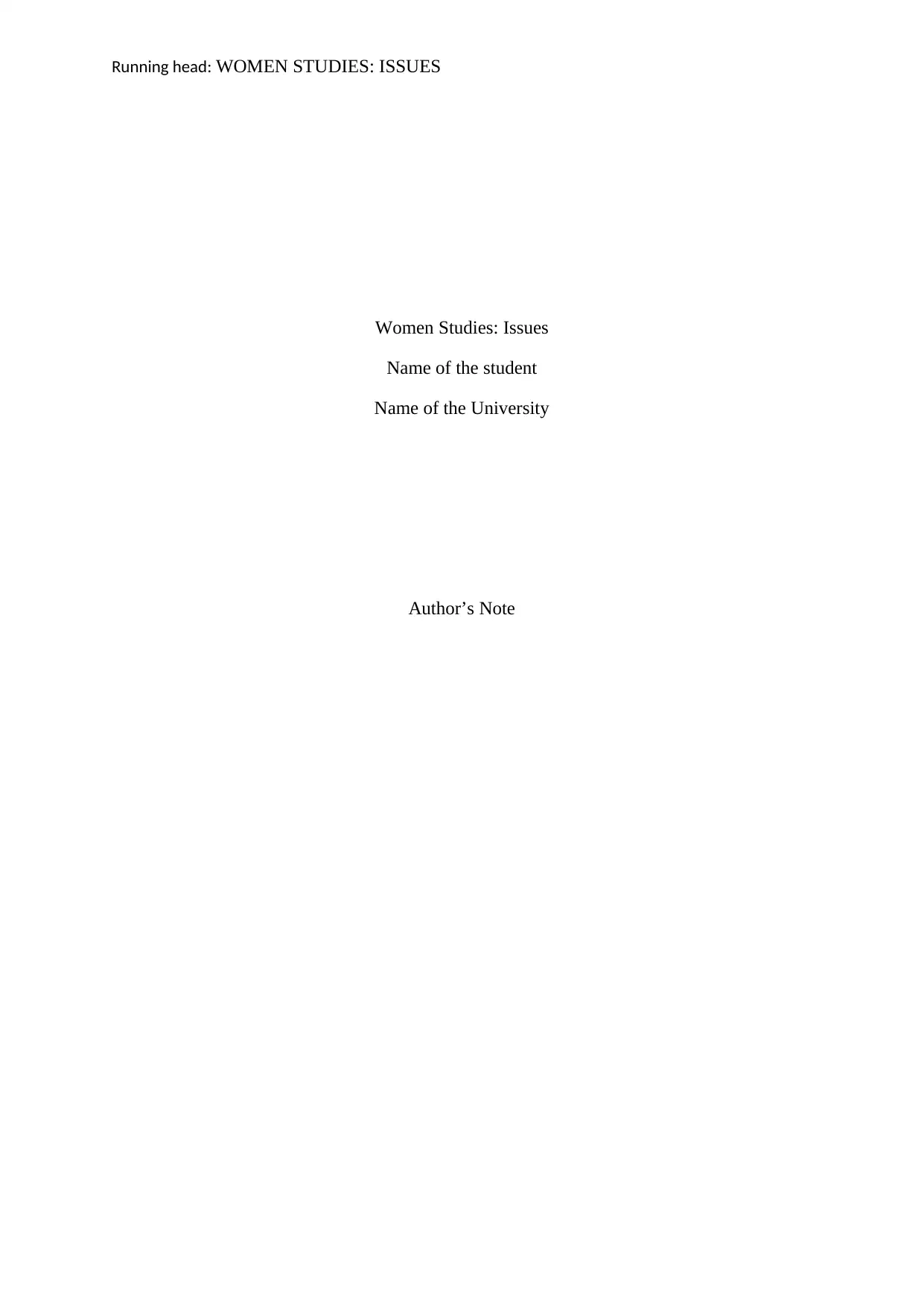
Running head: WOMEN STUDIES: ISSUES
Women Studies: Issues
Name of the student
Name of the University
Author’s Note
Women Studies: Issues
Name of the student
Name of the University
Author’s Note
Paraphrase This Document
Need a fresh take? Get an instant paraphrase of this document with our AI Paraphraser
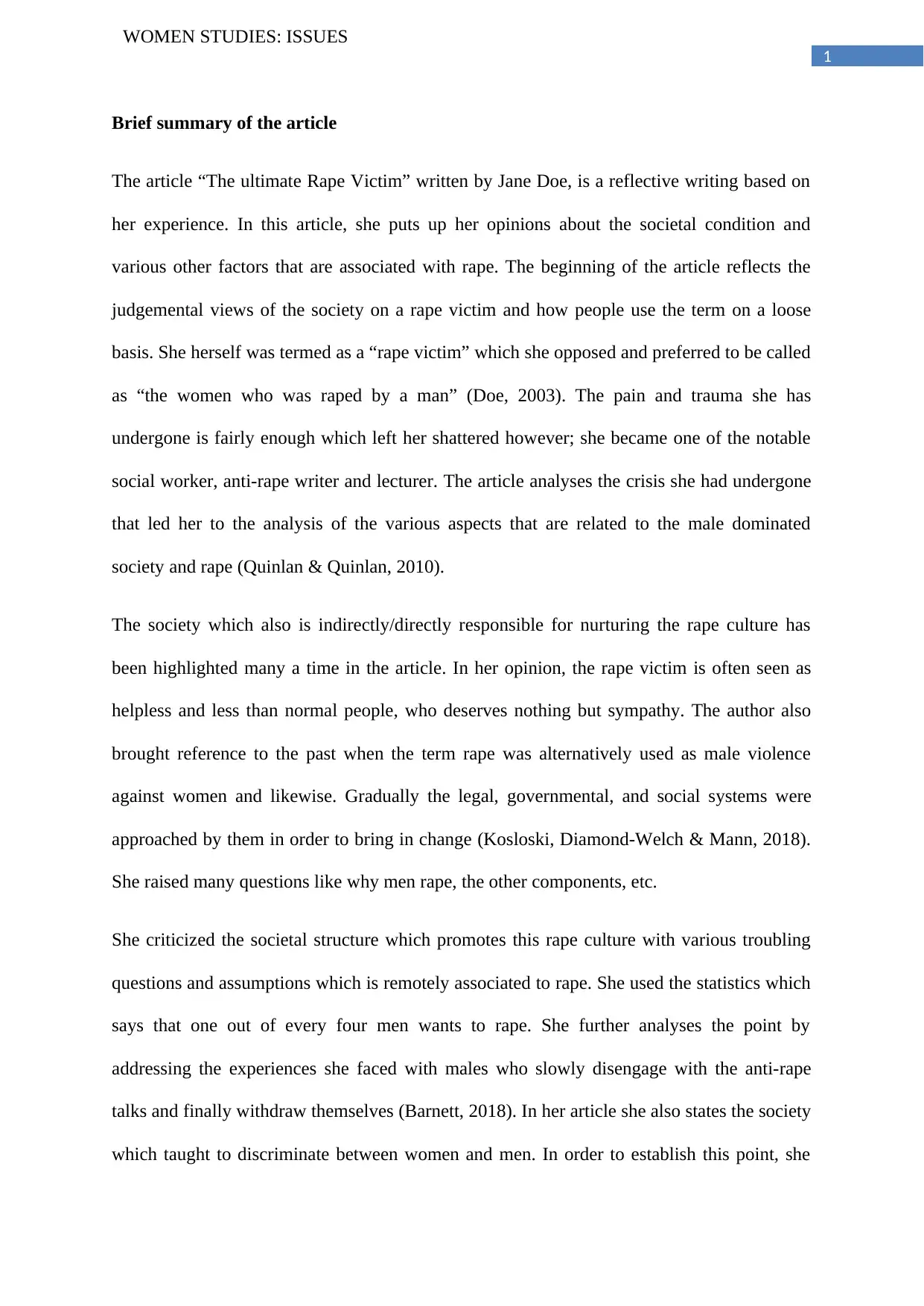
1
WOMEN STUDIES: ISSUES
Brief summary of the article
The article “The ultimate Rape Victim” written by Jane Doe, is a reflective writing based on
her experience. In this article, she puts up her opinions about the societal condition and
various other factors that are associated with rape. The beginning of the article reflects the
judgemental views of the society on a rape victim and how people use the term on a loose
basis. She herself was termed as a “rape victim” which she opposed and preferred to be called
as “the women who was raped by a man” (Doe, 2003). The pain and trauma she has
undergone is fairly enough which left her shattered however; she became one of the notable
social worker, anti-rape writer and lecturer. The article analyses the crisis she had undergone
that led her to the analysis of the various aspects that are related to the male dominated
society and rape (Quinlan & Quinlan, 2010).
The society which also is indirectly/directly responsible for nurturing the rape culture has
been highlighted many a time in the article. In her opinion, the rape victim is often seen as
helpless and less than normal people, who deserves nothing but sympathy. The author also
brought reference to the past when the term rape was alternatively used as male violence
against women and likewise. Gradually the legal, governmental, and social systems were
approached by them in order to bring in change (Kosloski, Diamond-Welch & Mann, 2018).
She raised many questions like why men rape, the other components, etc.
She criticized the societal structure which promotes this rape culture with various troubling
questions and assumptions which is remotely associated to rape. She used the statistics which
says that one out of every four men wants to rape. She further analyses the point by
addressing the experiences she faced with males who slowly disengage with the anti-rape
talks and finally withdraw themselves (Barnett, 2018). In her article she also states the society
which taught to discriminate between women and men. In order to establish this point, she
WOMEN STUDIES: ISSUES
Brief summary of the article
The article “The ultimate Rape Victim” written by Jane Doe, is a reflective writing based on
her experience. In this article, she puts up her opinions about the societal condition and
various other factors that are associated with rape. The beginning of the article reflects the
judgemental views of the society on a rape victim and how people use the term on a loose
basis. She herself was termed as a “rape victim” which she opposed and preferred to be called
as “the women who was raped by a man” (Doe, 2003). The pain and trauma she has
undergone is fairly enough which left her shattered however; she became one of the notable
social worker, anti-rape writer and lecturer. The article analyses the crisis she had undergone
that led her to the analysis of the various aspects that are related to the male dominated
society and rape (Quinlan & Quinlan, 2010).
The society which also is indirectly/directly responsible for nurturing the rape culture has
been highlighted many a time in the article. In her opinion, the rape victim is often seen as
helpless and less than normal people, who deserves nothing but sympathy. The author also
brought reference to the past when the term rape was alternatively used as male violence
against women and likewise. Gradually the legal, governmental, and social systems were
approached by them in order to bring in change (Kosloski, Diamond-Welch & Mann, 2018).
She raised many questions like why men rape, the other components, etc.
She criticized the societal structure which promotes this rape culture with various troubling
questions and assumptions which is remotely associated to rape. She used the statistics which
says that one out of every four men wants to rape. She further analyses the point by
addressing the experiences she faced with males who slowly disengage with the anti-rape
talks and finally withdraw themselves (Barnett, 2018). In her article she also states the society
which taught to discriminate between women and men. In order to establish this point, she
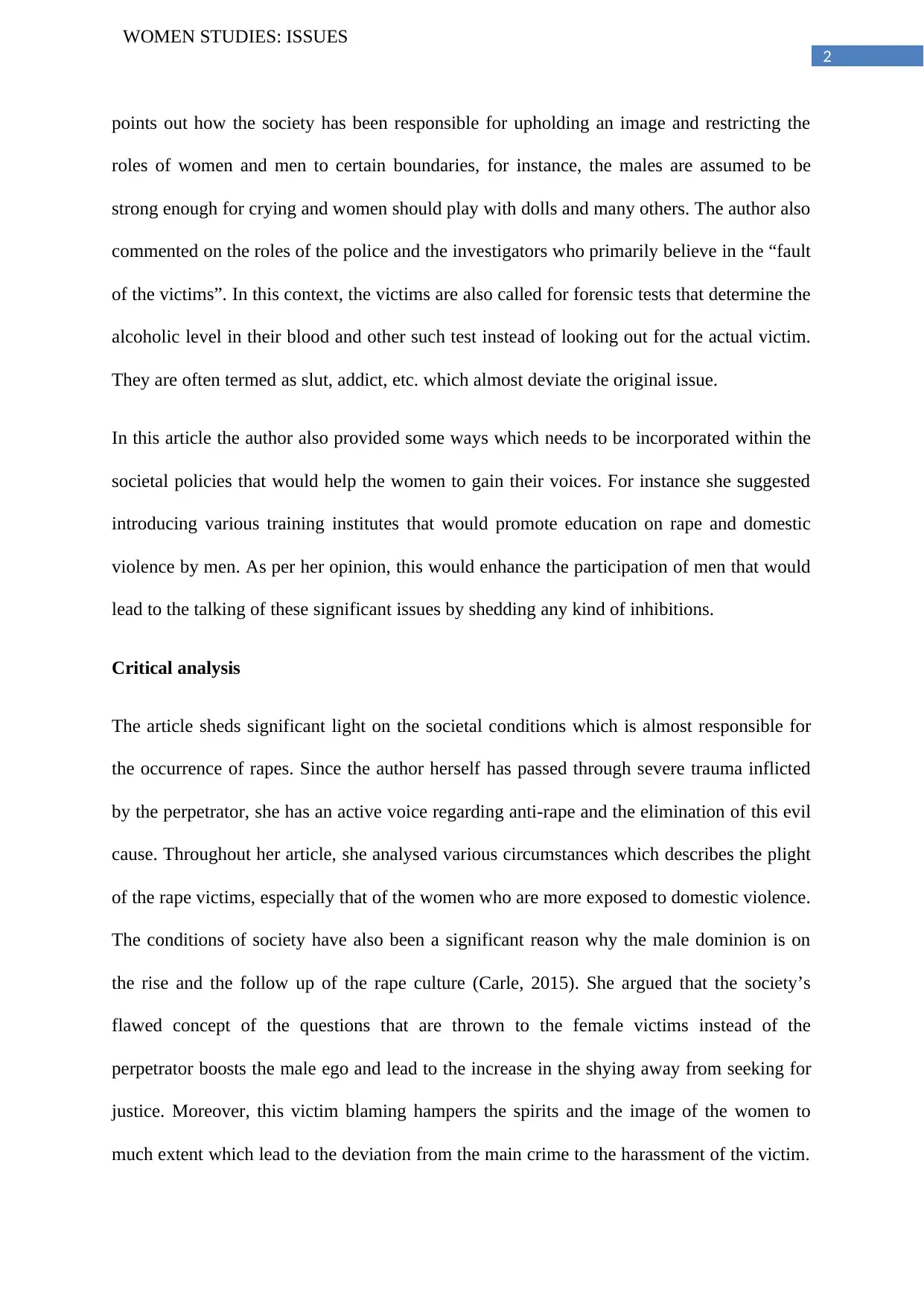
2
WOMEN STUDIES: ISSUES
points out how the society has been responsible for upholding an image and restricting the
roles of women and men to certain boundaries, for instance, the males are assumed to be
strong enough for crying and women should play with dolls and many others. The author also
commented on the roles of the police and the investigators who primarily believe in the “fault
of the victims”. In this context, the victims are also called for forensic tests that determine the
alcoholic level in their blood and other such test instead of looking out for the actual victim.
They are often termed as slut, addict, etc. which almost deviate the original issue.
In this article the author also provided some ways which needs to be incorporated within the
societal policies that would help the women to gain their voices. For instance she suggested
introducing various training institutes that would promote education on rape and domestic
violence by men. As per her opinion, this would enhance the participation of men that would
lead to the talking of these significant issues by shedding any kind of inhibitions.
Critical analysis
The article sheds significant light on the societal conditions which is almost responsible for
the occurrence of rapes. Since the author herself has passed through severe trauma inflicted
by the perpetrator, she has an active voice regarding anti-rape and the elimination of this evil
cause. Throughout her article, she analysed various circumstances which describes the plight
of the rape victims, especially that of the women who are more exposed to domestic violence.
The conditions of society have also been a significant reason why the male dominion is on
the rise and the follow up of the rape culture (Carle, 2015). She argued that the society’s
flawed concept of the questions that are thrown to the female victims instead of the
perpetrator boosts the male ego and lead to the increase in the shying away from seeking for
justice. Moreover, this victim blaming hampers the spirits and the image of the women to
much extent which lead to the deviation from the main crime to the harassment of the victim.
WOMEN STUDIES: ISSUES
points out how the society has been responsible for upholding an image and restricting the
roles of women and men to certain boundaries, for instance, the males are assumed to be
strong enough for crying and women should play with dolls and many others. The author also
commented on the roles of the police and the investigators who primarily believe in the “fault
of the victims”. In this context, the victims are also called for forensic tests that determine the
alcoholic level in their blood and other such test instead of looking out for the actual victim.
They are often termed as slut, addict, etc. which almost deviate the original issue.
In this article the author also provided some ways which needs to be incorporated within the
societal policies that would help the women to gain their voices. For instance she suggested
introducing various training institutes that would promote education on rape and domestic
violence by men. As per her opinion, this would enhance the participation of men that would
lead to the talking of these significant issues by shedding any kind of inhibitions.
Critical analysis
The article sheds significant light on the societal conditions which is almost responsible for
the occurrence of rapes. Since the author herself has passed through severe trauma inflicted
by the perpetrator, she has an active voice regarding anti-rape and the elimination of this evil
cause. Throughout her article, she analysed various circumstances which describes the plight
of the rape victims, especially that of the women who are more exposed to domestic violence.
The conditions of society have also been a significant reason why the male dominion is on
the rise and the follow up of the rape culture (Carle, 2015). She argued that the society’s
flawed concept of the questions that are thrown to the female victims instead of the
perpetrator boosts the male ego and lead to the increase in the shying away from seeking for
justice. Moreover, this victim blaming hampers the spirits and the image of the women to
much extent which lead to the deviation from the main crime to the harassment of the victim.
⊘ This is a preview!⊘
Do you want full access?
Subscribe today to unlock all pages.

Trusted by 1+ million students worldwide
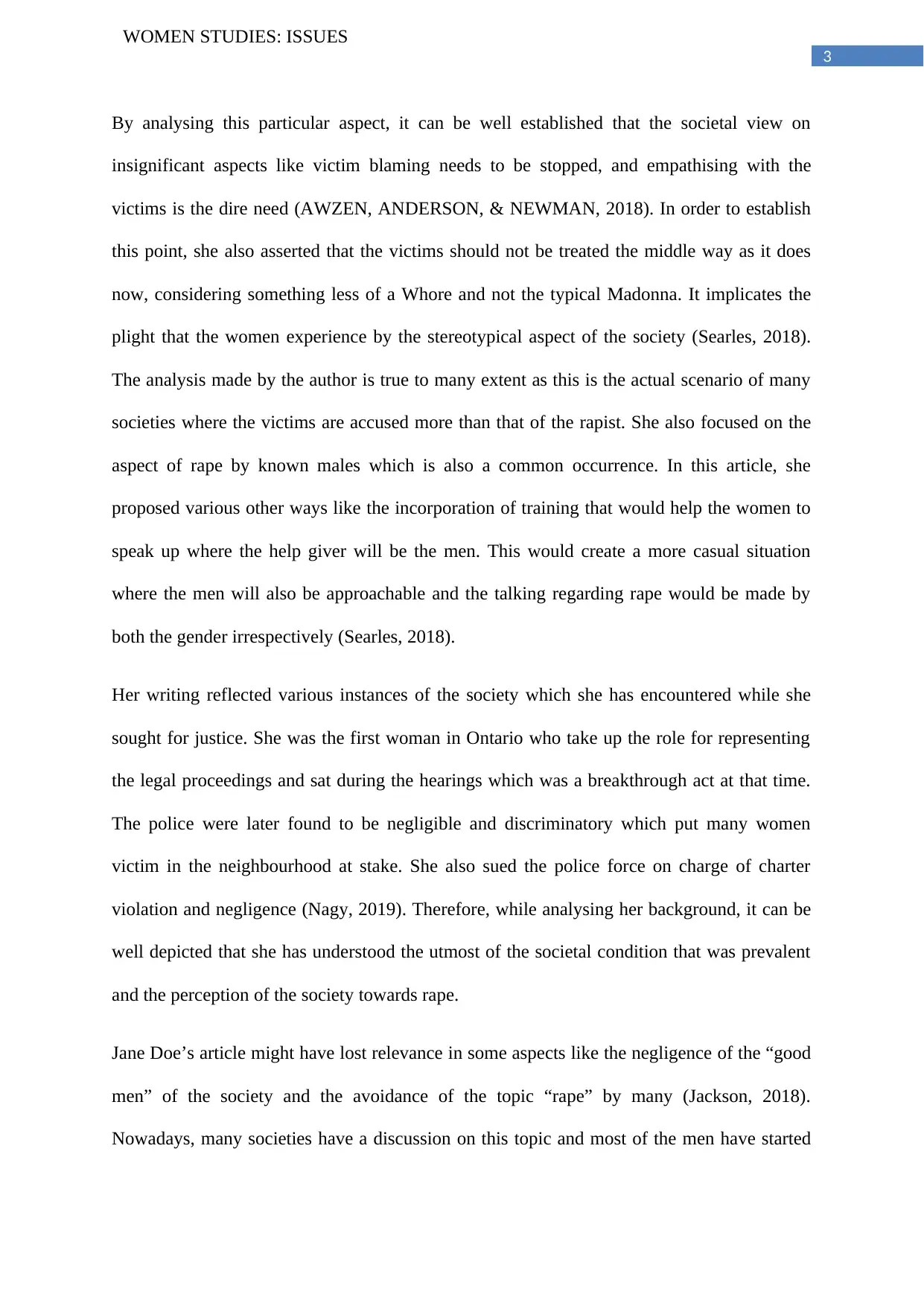
3
WOMEN STUDIES: ISSUES
By analysing this particular aspect, it can be well established that the societal view on
insignificant aspects like victim blaming needs to be stopped, and empathising with the
victims is the dire need (AWZEN, ANDERSON, & NEWMAN, 2018). In order to establish
this point, she also asserted that the victims should not be treated the middle way as it does
now, considering something less of a Whore and not the typical Madonna. It implicates the
plight that the women experience by the stereotypical aspect of the society (Searles, 2018).
The analysis made by the author is true to many extent as this is the actual scenario of many
societies where the victims are accused more than that of the rapist. She also focused on the
aspect of rape by known males which is also a common occurrence. In this article, she
proposed various other ways like the incorporation of training that would help the women to
speak up where the help giver will be the men. This would create a more casual situation
where the men will also be approachable and the talking regarding rape would be made by
both the gender irrespectively (Searles, 2018).
Her writing reflected various instances of the society which she has encountered while she
sought for justice. She was the first woman in Ontario who take up the role for representing
the legal proceedings and sat during the hearings which was a breakthrough act at that time.
The police were later found to be negligible and discriminatory which put many women
victim in the neighbourhood at stake. She also sued the police force on charge of charter
violation and negligence (Nagy, 2019). Therefore, while analysing her background, it can be
well depicted that she has understood the utmost of the societal condition that was prevalent
and the perception of the society towards rape.
Jane Doe’s article might have lost relevance in some aspects like the negligence of the “good
men” of the society and the avoidance of the topic “rape” by many (Jackson, 2018).
Nowadays, many societies have a discussion on this topic and most of the men have started
WOMEN STUDIES: ISSUES
By analysing this particular aspect, it can be well established that the societal view on
insignificant aspects like victim blaming needs to be stopped, and empathising with the
victims is the dire need (AWZEN, ANDERSON, & NEWMAN, 2018). In order to establish
this point, she also asserted that the victims should not be treated the middle way as it does
now, considering something less of a Whore and not the typical Madonna. It implicates the
plight that the women experience by the stereotypical aspect of the society (Searles, 2018).
The analysis made by the author is true to many extent as this is the actual scenario of many
societies where the victims are accused more than that of the rapist. She also focused on the
aspect of rape by known males which is also a common occurrence. In this article, she
proposed various other ways like the incorporation of training that would help the women to
speak up where the help giver will be the men. This would create a more casual situation
where the men will also be approachable and the talking regarding rape would be made by
both the gender irrespectively (Searles, 2018).
Her writing reflected various instances of the society which she has encountered while she
sought for justice. She was the first woman in Ontario who take up the role for representing
the legal proceedings and sat during the hearings which was a breakthrough act at that time.
The police were later found to be negligible and discriminatory which put many women
victim in the neighbourhood at stake. She also sued the police force on charge of charter
violation and negligence (Nagy, 2019). Therefore, while analysing her background, it can be
well depicted that she has understood the utmost of the societal condition that was prevalent
and the perception of the society towards rape.
Jane Doe’s article might have lost relevance in some aspects like the negligence of the “good
men” of the society and the avoidance of the topic “rape” by many (Jackson, 2018).
Nowadays, many societies have a discussion on this topic and most of the men have started
Paraphrase This Document
Need a fresh take? Get an instant paraphrase of this document with our AI Paraphraser
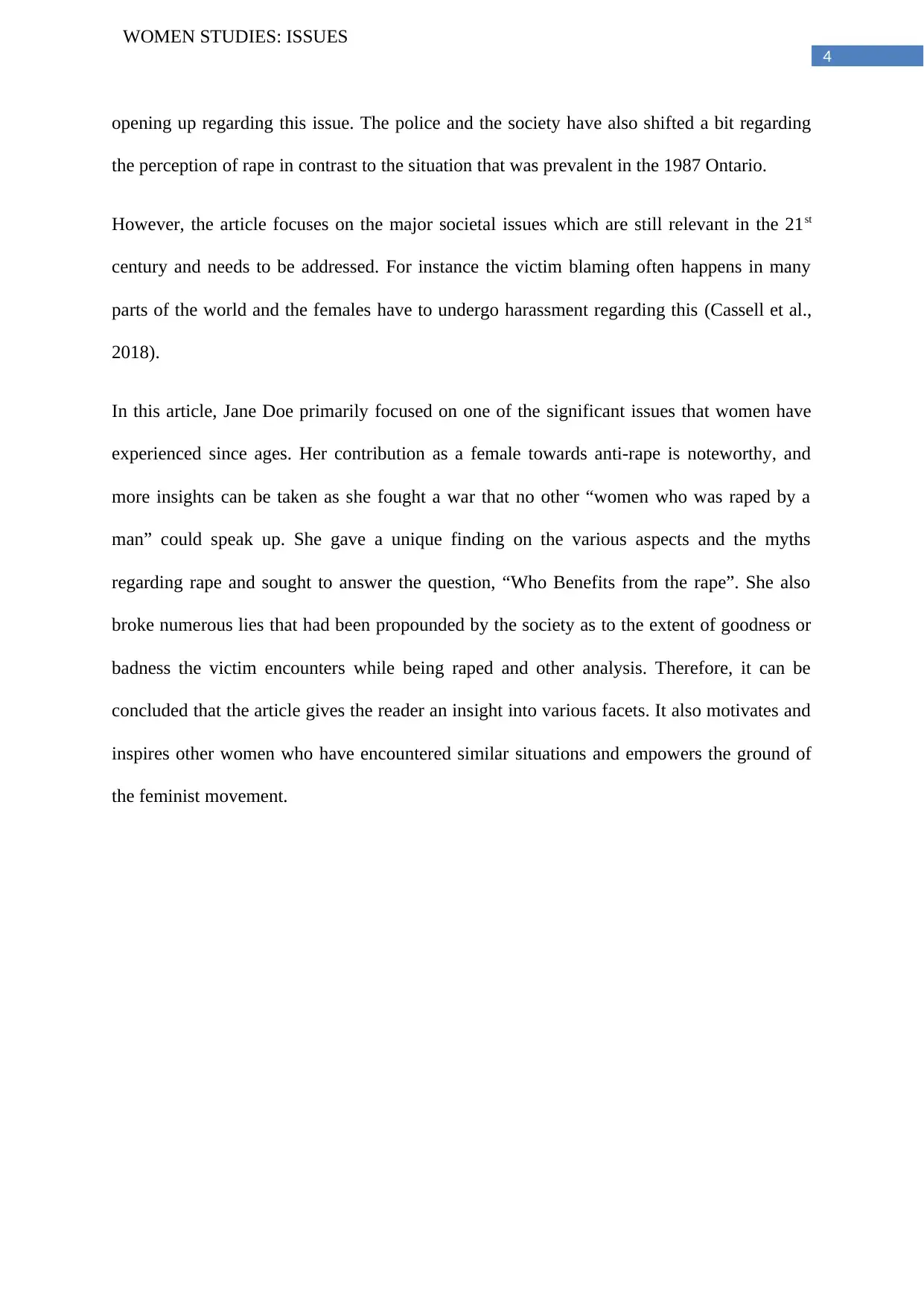
4
WOMEN STUDIES: ISSUES
opening up regarding this issue. The police and the society have also shifted a bit regarding
the perception of rape in contrast to the situation that was prevalent in the 1987 Ontario.
However, the article focuses on the major societal issues which are still relevant in the 21st
century and needs to be addressed. For instance the victim blaming often happens in many
parts of the world and the females have to undergo harassment regarding this (Cassell et al.,
2018).
In this article, Jane Doe primarily focused on one of the significant issues that women have
experienced since ages. Her contribution as a female towards anti-rape is noteworthy, and
more insights can be taken as she fought a war that no other “women who was raped by a
man” could speak up. She gave a unique finding on the various aspects and the myths
regarding rape and sought to answer the question, “Who Benefits from the rape”. She also
broke numerous lies that had been propounded by the society as to the extent of goodness or
badness the victim encounters while being raped and other analysis. Therefore, it can be
concluded that the article gives the reader an insight into various facets. It also motivates and
inspires other women who have encountered similar situations and empowers the ground of
the feminist movement.
WOMEN STUDIES: ISSUES
opening up regarding this issue. The police and the society have also shifted a bit regarding
the perception of rape in contrast to the situation that was prevalent in the 1987 Ontario.
However, the article focuses on the major societal issues which are still relevant in the 21st
century and needs to be addressed. For instance the victim blaming often happens in many
parts of the world and the females have to undergo harassment regarding this (Cassell et al.,
2018).
In this article, Jane Doe primarily focused on one of the significant issues that women have
experienced since ages. Her contribution as a female towards anti-rape is noteworthy, and
more insights can be taken as she fought a war that no other “women who was raped by a
man” could speak up. She gave a unique finding on the various aspects and the myths
regarding rape and sought to answer the question, “Who Benefits from the rape”. She also
broke numerous lies that had been propounded by the society as to the extent of goodness or
badness the victim encounters while being raped and other analysis. Therefore, it can be
concluded that the article gives the reader an insight into various facets. It also motivates and
inspires other women who have encountered similar situations and empowers the ground of
the feminist movement.
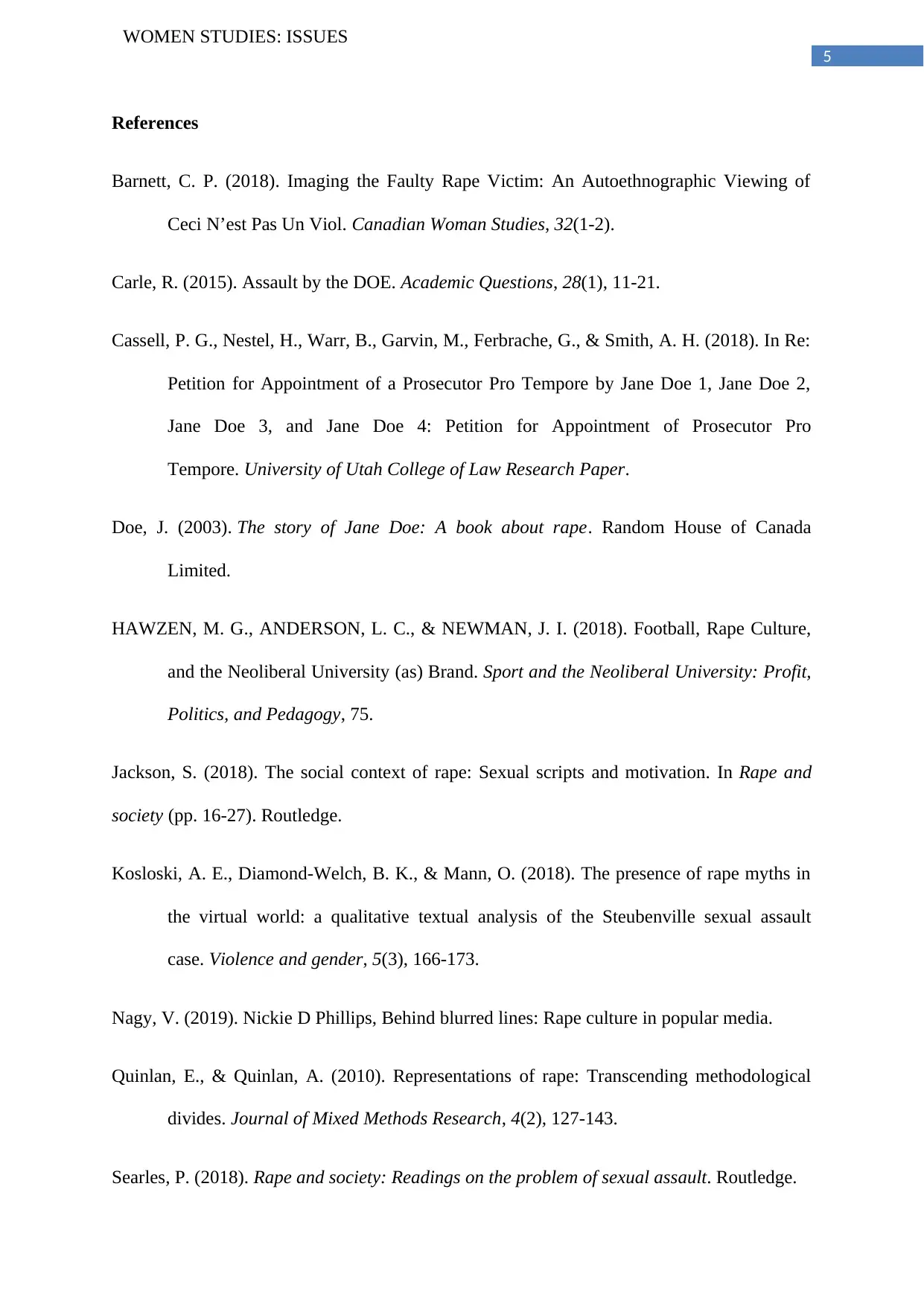
5
WOMEN STUDIES: ISSUES
References
Barnett, C. P. (2018). Imaging the Faulty Rape Victim: An Autoethnographic Viewing of
Ceci N’est Pas Un Viol. Canadian Woman Studies, 32(1-2).
Carle, R. (2015). Assault by the DOE. Academic Questions, 28(1), 11-21.
Cassell, P. G., Nestel, H., Warr, B., Garvin, M., Ferbrache, G., & Smith, A. H. (2018). In Re:
Petition for Appointment of a Prosecutor Pro Tempore by Jane Doe 1, Jane Doe 2,
Jane Doe 3, and Jane Doe 4: Petition for Appointment of Prosecutor Pro
Tempore. University of Utah College of Law Research Paper.
Doe, J. (2003). The story of Jane Doe: A book about rape. Random House of Canada
Limited.
HAWZEN, M. G., ANDERSON, L. C., & NEWMAN, J. I. (2018). Football, Rape Culture,
and the Neoliberal University (as) Brand. Sport and the Neoliberal University: Profit,
Politics, and Pedagogy, 75.
Jackson, S. (2018). The social context of rape: Sexual scripts and motivation. In Rape and
society (pp. 16-27). Routledge.
Kosloski, A. E., Diamond-Welch, B. K., & Mann, O. (2018). The presence of rape myths in
the virtual world: a qualitative textual analysis of the Steubenville sexual assault
case. Violence and gender, 5(3), 166-173.
Nagy, V. (2019). Nickie D Phillips, Behind blurred lines: Rape culture in popular media.
Quinlan, E., & Quinlan, A. (2010). Representations of rape: Transcending methodological
divides. Journal of Mixed Methods Research, 4(2), 127-143.
Searles, P. (2018). Rape and society: Readings on the problem of sexual assault. Routledge.
WOMEN STUDIES: ISSUES
References
Barnett, C. P. (2018). Imaging the Faulty Rape Victim: An Autoethnographic Viewing of
Ceci N’est Pas Un Viol. Canadian Woman Studies, 32(1-2).
Carle, R. (2015). Assault by the DOE. Academic Questions, 28(1), 11-21.
Cassell, P. G., Nestel, H., Warr, B., Garvin, M., Ferbrache, G., & Smith, A. H. (2018). In Re:
Petition for Appointment of a Prosecutor Pro Tempore by Jane Doe 1, Jane Doe 2,
Jane Doe 3, and Jane Doe 4: Petition for Appointment of Prosecutor Pro
Tempore. University of Utah College of Law Research Paper.
Doe, J. (2003). The story of Jane Doe: A book about rape. Random House of Canada
Limited.
HAWZEN, M. G., ANDERSON, L. C., & NEWMAN, J. I. (2018). Football, Rape Culture,
and the Neoliberal University (as) Brand. Sport and the Neoliberal University: Profit,
Politics, and Pedagogy, 75.
Jackson, S. (2018). The social context of rape: Sexual scripts and motivation. In Rape and
society (pp. 16-27). Routledge.
Kosloski, A. E., Diamond-Welch, B. K., & Mann, O. (2018). The presence of rape myths in
the virtual world: a qualitative textual analysis of the Steubenville sexual assault
case. Violence and gender, 5(3), 166-173.
Nagy, V. (2019). Nickie D Phillips, Behind blurred lines: Rape culture in popular media.
Quinlan, E., & Quinlan, A. (2010). Representations of rape: Transcending methodological
divides. Journal of Mixed Methods Research, 4(2), 127-143.
Searles, P. (2018). Rape and society: Readings on the problem of sexual assault. Routledge.
⊘ This is a preview!⊘
Do you want full access?
Subscribe today to unlock all pages.

Trusted by 1+ million students worldwide
1 out of 6
Related Documents
Your All-in-One AI-Powered Toolkit for Academic Success.
+13062052269
info@desklib.com
Available 24*7 on WhatsApp / Email
![[object Object]](/_next/static/media/star-bottom.7253800d.svg)
Unlock your academic potential
Copyright © 2020–2025 A2Z Services. All Rights Reserved. Developed and managed by ZUCOL.





